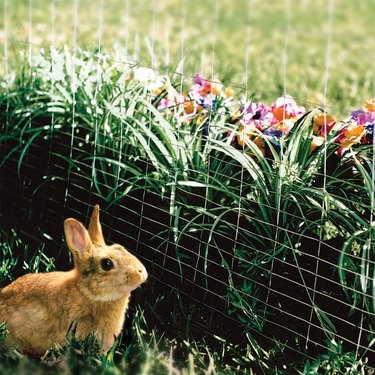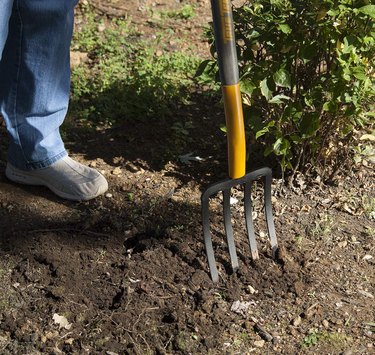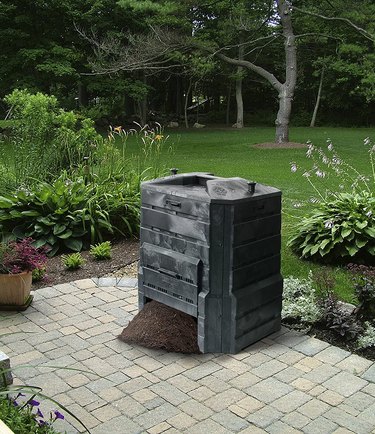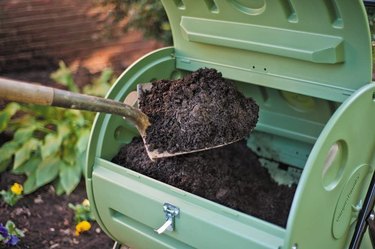Composting isn't magic but it can definitely feel like magic when you first get started. It is the process of turning kitchen detritus and yard clippings into a valuable soil additive called compost. You have surely seen bags of compost in the garden store, and may have even bought some without knowing how very easy and rewarding it is to make your own.
If you are new to composting, you'll want to get an overview before you dive in, including information about the many ways adding compost to soil can help your plants. Once you understand composting basics, you can start making organic compost in your own back yard.
Video of the Day
Video of the Day
Nature's Composting Process
Walking through forested wildlands, you are seeing nature's composting process at work. The trees and plants are nurtured by the minerals and nutrients in the soil. Leaves appear in springtime, then fall to the ground in autumn. Over winter, they blanket the soil and keep it from getting too cold. As the months pass and rains fall, the leaves disintegrate into the soil, adding the nutrients the trees require to produce leaves the following spring.
When you start composting in the backyard, you echo this natural process. Composting involves piling up kitchen scraps like veggie and fruit peelings and mixing it with dried leaves and grass. As time passes, you add water and blend the materials, allowing them to decompose. The resulting compost – also called humus – looks like rich, forest soil – dark, crumbly and ready to mix into your soil.
Benefits of Composting
Compost is really the answer to many of your plants' prayers. You have to remember that they rely on their roots to uptake water and nutrients to keep the leaves, flowers and fruits coming. When you mix organic compost into the soil, it enriches the soil in several ways.
- It improves the physical characteristics of the soil, making clay soil less dense and sandy soil more substantial.
- It ups the soil's capacity to hold only water and nutrients. In lean soils, water can run right through, carrying nutrients with it.
- It makes the soil more porous, increasing aeration.
When you start composting in your backyard, all of these benefits are even sweeter because it's free! You aren't paying an arm and a leg for every sack of compost you use. In fact, you cut down on trash by making use of both kitchen scraps and yard clippings. Taking an even larger view, by composting, you reduce the use of chemical fertilizers and also reduce methane emissions from landfills, lowering your carbon footprint.
There may be a downside to composting, but most gardeners would be hard-pressed to name one.
Building Organic Compost
There's no reason to let the word "organic"make you nervous. All it means, in a compost context, is that the material you are composting used to be alive. Nothing inorganic – like rubber or chemicals – belongs in your compost heap.
People describing the composting process like to talk about green material and brown material. Both green and brown are organic, but the former is moist while the latter is dry. For example, carrot peelings are moist so they are green material; autumn leaves have dried out so they are brown. Although there are a variety of ways to compost, the most basic recipe for building compost is to pile up a layer of green materials, then a layer of brown materials that is approximately the same weight. This is repeated over and over.
The reason for the green/brown distinction is because these organic materials have varying ratios of carbon (C) to nitrogen (N). The C:N ratio influences the speed of decomposition. The ideal C:N ratio for a compost pile is 30:1 which can be approximated by adding equal amounts of green and brown materials.
What to Compost
It's easier to understand the composting process when you look at a list of what can be added to the pile. All of these materials can be added to the compost pile:
- peels and cores of fruits
- peels and pieces of vegetables
- eggshells
- dried grass clippings
- yard clippings
- dry leaves
- hay
- straw
- sawdust
- wood chips
- newspaper (shredded)
- cardboard
- coffee grounds
- tea bags
- nut shells
- cotton fabric (e.g. rags)
- wool fabric
- wood ash
- chicken/cow/horse manure
What Not to Compost
Some materials do not belong in the compost and should be avoided completely. These include:
- weeds (because their seeds will spread and sprout in your garden0
- yard clippings if the plants were treated with toxins like chemical pesticides (the toxins can kill your plant and/or beneficial composting organisms)
- coal/charcoal ash (contain substances harmful to garden plants)
- meat/fish products including fats and lard( these break down very slowly, smell bad and attract rodents and bugs)
- dairy products (these smell bad as they decompose and attract rodents)
- black walnut tree twigs or leaves (contain materials that block plant growth)
- any plant parts if the plant has pests or is diseased (may pass pests or disease on to other plants)
- dog feces (can have parasites, bacteria or other germs you don't want in your veggie garden)
- used cat litter (can have parasites, bacteria or other germs you don't want in your veggie garden)
- wet grass clippings (if you dump a wheelbarrow load of just-cut grass clippings on the compost, it will compact, preventing decomposition)
How to Compost
So many gardeners compost these days that you can find many different composting system bins in commerce. But a basic composting system doesn't require an outlay of cash. There are just a few steps:
- Select the location: find a flat, secluded area in the backyard that gets some shade and has decent drainage. You'll want a compost area of at least 4 feet square.
- Pile the compost material directly on the ground in this area, or enclose the pile area with wire fencing, bricks, cement blocks or wood. One way to do this is with four stakes on the four corners with wire fencing wrapped around it. A product like YARDGARD Welded Wire Economy Fence, makes this easy. It is galvanized wire fencing, 36 inches high and 50 feet long. Lightweight and sturdy, the fencing is easy to install and easy to use.

- Add the compost using the green/brown layering approach.
- Alternatively, use a three-layer approach: 1) a layer of coarse plant material like branches to let air into the pile; 2) a layer of finer plant material like kitchen detritus and plant clippings; 3) a thin layer of manure to activate the decomposition process with microorganisms and nitrogen.
Adding in Air and Water
In order to assist your organic materials to decompose cleanly and rapidly, you'll need to help them decompose. Decomposition requires both water and air. Rain can supply the water if you get a good rainfall every few weeks, year round. If not, you'll have to add water to the pile. It's important that it doesn't get waterlogged, which is why you want to pick a site with good drainage.
To "add" air to the pile, you must turn the material in the compost pile. A garden fork works for this, like the True Temper 2812200 4-Tine Spading Digging Fork with a super-strong forged spading fork head with four diamond-pointed steel tines for easy soil penetration. Turn the compost pile every week during the summer and once a month during the winter. After three or four months, the compost is ready to use in the garden. It's ideal to have several piles going so that you can use finished compost from one while filling up the others.

Getting Fancier
You won't necessarily get better compost from a fancier compost system, but you can make the entire process easier for yourself and get your compost to decompose more rapidly.
One step up from the simple pile or homemade compost area is a compost bin. These can be simple, like plastic cubes. Some products, like Algreen Products Soil Saver Classic Compost Bin, have a locking lid to keep wildlife out as well as a large opening that provides good access for removal of compost. With composts bins, all odors are contained and you have more control over the amount of water that gets in. This can be extremely useful in very rainy areas.

Even more convenient is the rotating bin like the Mantis CT08002 Back Porch ComposTumbler. In this product, the compost tumbler barrel is suspended on a stand for easy access. You can turn the compost simply by turning the crank, and there is a removable door to make filling and emptying the barrel easier. The tumbler has air vents on top to allow oxygen in and drainage vents to allow water to exit.

As you become more sophisticated at composting, you might want to check out vermicomposting, the most popular indoor composting method that uses worms to speed along the process. Red worms in vermicomposting bins eat the kitchen and yard scraps, breaking it down quickly into high-quality compost called castings. It's helpful to get a kit to start, like the Vermihut Plus 5-Tray Worm Compost Bin. It's sturdy, easy to assemble and use for first-timers, plus includes traps that keep ants from invading the bin.
It's Worth It!
Getting started on composting is easy - a matter of finding a location, starting a compost pile or bin, and layering in kitchen peelings, yard clippings and anything else on the compost list. In a matter of few months, you'll have rich, dark humus to blend into your garden soil, improving its physical characteristics, increasing its capacity to hold water and making it more porous. Composting is fun, practical and cheap, and your plants will be utterly thrilled.